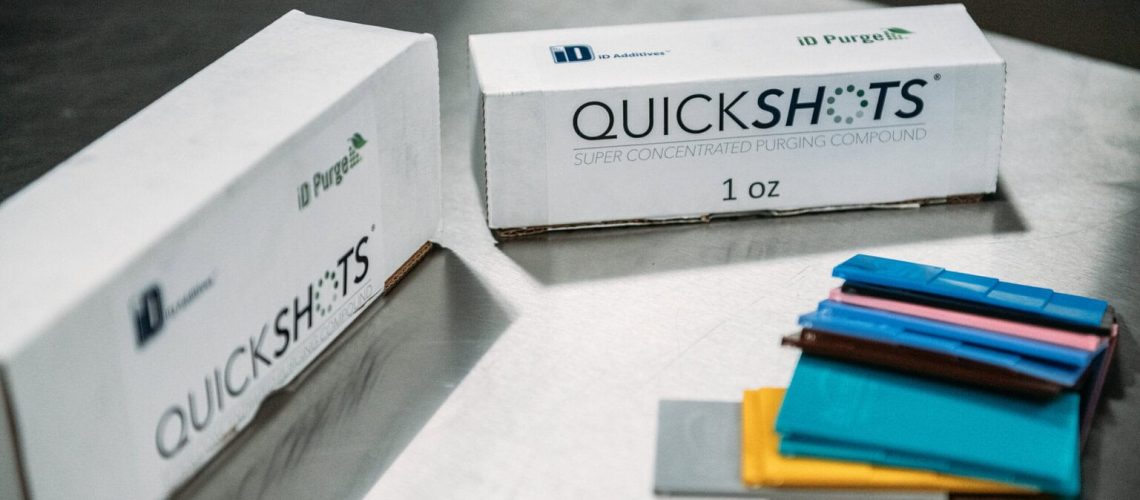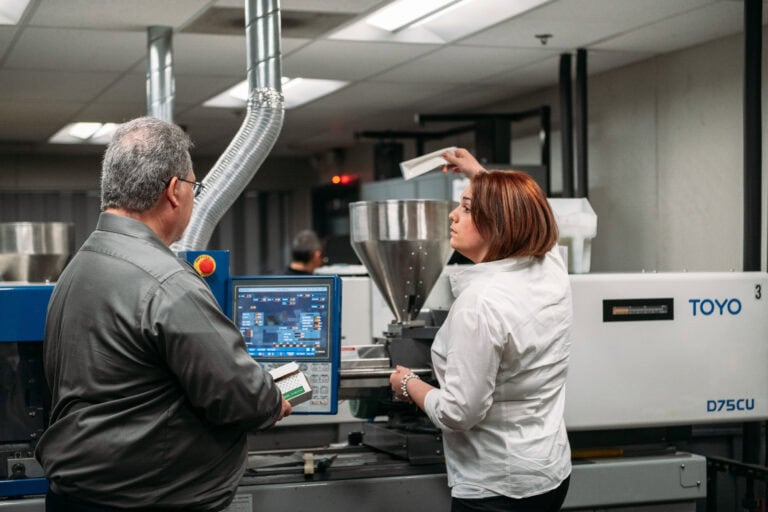By Dave Denzel
Holidays are time for fun and relaxation, a time to shut down production for a bit and not think about producing parts. The last thing you want to do is worry about oxidation from resins left in your equipment and tooling.
Left unattended, resins oxidize in plastics machinery like the barrels of injection molding machines, causing carbon contamination.
That’s why before a shutdown we advise you purge your equipment with a commercial purging compound (CPC) like iD Additives Liquid Purge. A CPC is more thermally stable, particularly during the extreme heat variations that occur when shutting down and later restarting.
3 reasons purging pays off
Implementing purge products into your preventive maintenance program essential to any plastic processing facility for a number of reasons.
First, purging your injection molding, blow molding or extrusion equipment reduces scrap. Not only is each scrap part a lost sale, but it also wastes valuable machine time. If you’re seeing black specks in your parts, they are possibly being caused by resident resin degradation resulting form the lack of a good purging program.
Second, speaking of machine utilization, proper purging of your machines as part of your holiday shutdown regimen means more machine uptime when you return to work. That means more business opportunities.
And, because your machines are working as much as they can, so are your operators. You won’t have employees standing around with nothing to do while your equipment is down.
Avoid home remedies
It’s not uncommon for shop floor personnel to try to purge equipment with home remedies. We’ve seen folks use anything from wood chips to hand soaps and other less-than-ideal materials.
Consider the time it takes to remove your nozzles and dies — why go to all that trouble and risk damaging your equipment? Not to mention that unsuitable materials do nothing to clean other critical components like check rings.
Trust me – you can dig yourself into a real deep hole by not choosing a CPC to purge plastics equipment before a holiday shutdown. How deep? One weekend while visiting a shop preparing for a Monday startup, I saw a huge puff of smoke. Turns out the crew was running ABS and had a problem with screw slippage – so they took the nozzle off, broke up a bunch of wood pallets and shoved the chips into the feed throat. By the way, the wood was treated – so we ended up evacuating the building because people were starting to gag and choke because of the chemicals in the wood.
So if you’re going to tear apart your equipment anyway, don’t attempt to purge it with material not engineered to clean it. Having a proven CPC in your shop will quickly and easily let your purge your plastics equipment the right way.
How to purge plastics equipment step by step
So how do you properly use purging compound to clean your plastics equipment before a holiday shutdown? We recommend this preventive maintenance program for injection molding, extrusion or blow molding processes.
- Clean upstream equipment before introducing the purge. Clean your hopper, make sure the feed throat is clear and the magnet area is cleaned out really well. Clean dryers and blenders as well.
- Purge the screw and barrel to remove contamination and buildup. This will help clean check rings, ball checks and mixing nozzles. Typically you only need one or two barrel capacities for this. For best results, reduce your shot size to 25% of barrel capacity and then start cleaning. Purge in short bursts to ensure the check spring is moving properly and that it’s moving quite a bit.
- Purge the hot runner system and manifold system after the screw and barrel have been systematically purged clean to ensure that the mold and its components are free of contamination.
- Purge every two or three days and evaluate machine performance.
- Seal the barrel with purge to remove oxygen and eliminate oxidation while preventing carbon buildup.
- Leave residual purge in the barrel as a failsafe as peace of mind for returning employees. Purge compound is stable, so there’s no harm in leaving a little behind in case returning employees aren’t sure the machine was properly purged and shutdown before the holiday break.
Schedule a trial to see purging in action
A great way to become familiar with the benefits of proper, routine purging of your plastics processing equipment is to schedule a purging trial.
For instance, a customer who was experiencing signifcant issues with carbon and black specks called us in to get rid of them.
Starting with a mechanical purge, we cleaned their barrel and screw. We introduced the next production resin, and within about 20 minutes the black specks returned – along with some coloring, which we speculated might be caused by layers of residual materials on the screw.
With a second round of purging, we began removing another color – a green they had been running through the machine about a week prior. And just as our output began cleaning up, a third color appeared. We performed a third and then a fourth purge, encountering another color, red, in the process. That red had not been run for 10 months.
After that fourth purge, we examined the feed throat with a mirror and flashlight and saw no remaining material – and within five shots the machine was running good parts again. After two hours of monitoring output, we still saw no black specks.
Since that trial, that customer began running regular purge as part of a consistent maintenance program, cleaning after every color and purging before weekend shutdowns.
Final thoughts
Now that you know how to purge your plastics processing equipment for a holiday or weekend shutdown, you can ensure a trouble-free startup when everyone returns from the break.
That leaves one thing: choosing the right commercial purging compound. No two CPCs are alike. You’ll want to purchase a tested and proven purge compound that performs better than resin and regrind – and certainly better than any home remedies.
You’ll need to choose the proper CPC for your material and machine application. And, you’ll need to train your operators to ensure they have the skill and confidence to clean equipment properly for a smooth shutdown that ensures a quick startup with little to no scrap.
Check out our YouTube video on Holiday Shutdowns: https://www.youtube.com/watch?v=poQmTRSGyJI&t=1s





